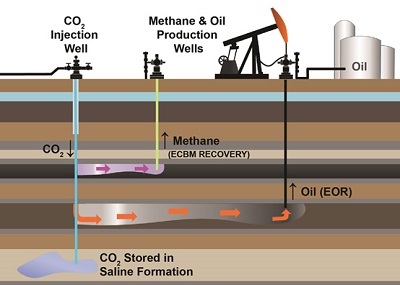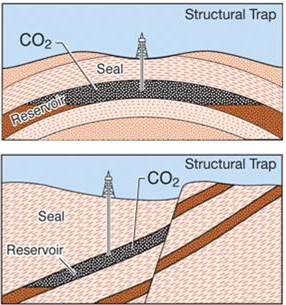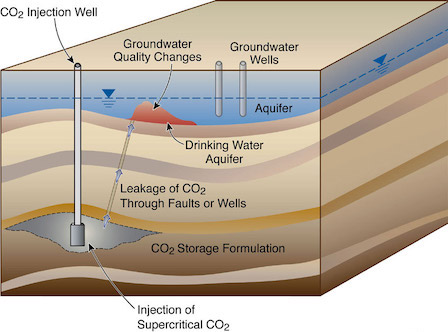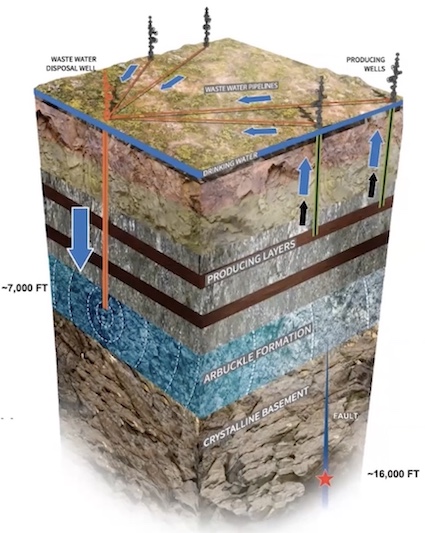Let's bury our CO2. What could possibly go wrong?
 We did not act early enough on climate change, and we continue to burn through our carbon budget too fast. As a result, we are faced with the need to capture and store away increasingly large amounts of carbon dioxide (CO2). Trees are great at this but they can sequester at most a fraction of what’s needed. The International Energy Agency has estimated that we will need to capture 1.6 billion tons of CO2 by 2030 if we are to meet our climate goals, and five times that by 2050. Our plan is to bury it deep inside the planet. (1) Many people think that is pretty straight-forward, but do we know how to do it and can we do it fast enough?
We did not act early enough on climate change, and we continue to burn through our carbon budget too fast. As a result, we are faced with the need to capture and store away increasingly large amounts of carbon dioxide (CO2). Trees are great at this but they can sequester at most a fraction of what’s needed. The International Energy Agency has estimated that we will need to capture 1.6 billion tons of CO2 by 2030 if we are to meet our climate goals, and five times that by 2050. Our plan is to bury it deep inside the planet. (1) Many people think that is pretty straight-forward, but do we know how to do it and can we do it fast enough?
We have been burying CO2 on a small scale for many years. The fossil fuel industry has been injecting CO2 into some of its less productive oil wells and coal mines in an effort to extract more oil and methane. As shown in the picture below, carbon dioxide can also be stored in saline formations, large aquifers filled with brine in sedimentary rock, that are deep enough to accommodate pressurized CO2.
CO2 has been injected into coal beds and oil fields to help push out extra methane and oil. It has also been injected into saline reservoirs for storage. Source: National Energy Technology Laboratory
It turns out that we have a lot of these sedimentary basins in the US, both under land and off the coast. There appears to be more than enough room to store all of the CO2 we would ever need to store.
How is carbon dioxide stored in one of these basins? It is compressed and injected into the earth, typically at a depth of one or more kilometers. Once down there, it spreads out through pores in the sedimentary rock (e.g., sandstone or limestone) and is trapped by a (hopefully) impermeable “capstone” above the aquifer (e.g., slate), or possibly by faults in the rock, as shown below.

Carbon dioxide (gray) seeps through sedimentary pores (dark brown) before being trapped by a capstone (light brown, top) and/or shifted impermeable layers (bottom). Source: National Energy Technology Laboratory
Over the years as the carbon dioxide stays down there, some of it becomes trapped in the pores of the rocks, where it is less likely to leak. Some of it dissolves into the saline brine. And some of it reacts with the walls of the cavities to form minerals.
We have a fossil-trained workforce with the skills needed to evaluate the aquifers, build necessary pipelines, and drill, maintain, and monitor the wells. The cost of basic carbon storage is manageable, around $10-$20/ton, which is generally much less than the cost of capturing and transporting it. So this all seems pretty promising, right?
The crux is that we have to scale up very, very quickly. This year we are capturing about 40 Mt of CO2. We need to scale that by 40x in the next eight years to align with a pathway to net-zero by 2050. That is a massive acceleration from what at this point is still in many ways a science experiment.
There is much that we don’t understand about injecting into these aquifers, and in particular injecting quickly and safely. For example, the products of the reactions that occur when the CO2 mixes with the brine and the rocks can impede the injection itself. Minerals that form can clog the openings in the porous rock and precipitate can coat the rock surfaces and make them less reactive. A large aquifer can become pretty small and/or riddled with wells if we cannot figure out how to reduce these effects so the CO2 can disperse effectively.
There are risks of contaminating our drinking water. The CO2 injections can push saltier water upwards towards the drinking water. Or the CO2 itself can mix into the drinking water, acidifying it and leaching toxins from the rock. How do we detect and prevent these issues deep underground, especially when we are developing 100+ new sites every year?

Carbon dioxide can leak up through faults or along the casing of a well to acidify the drinking water supply. Image source: Berkeley Lab
You also get the potential for earthquakes when you are putting such a large volume of fluid deep into the Earth. We have seen in places as far flung as Oklahoma, Arkansas, Illinois, and West Texas that even a very small increase in pressure in some sedimentary aquifers can lead to substantial earthquakes. The oil and gas companies have seen this when they dispose of wastewater.

Waste water from productive wells in Oklahoma was injected into an aquifer 7000 feet below the surface. The slight resulting increase in pressure in this aquifer was transmitted through a fault in the crystalline basement below, leading to noticeable earthquakes. Source: Stanford Center for Carbon Storage webinar by Geophysicist and Stanford Professor Emeritus Mark Zoback
Slight pressure increases can be transmitted long distances to deeper and more brittle layers, which can result in larger tremors. In Oklahoma, earthquakes occurred at a depth of 6-7 km, far below where the wastewater was injected. The largest quake registered at 5.8. These tapered off only when wastewater injection was curtailed.
West Texas is seeing an effect very much like this right now. Earlier this year the Texas regulator of oil and gas wells moved to suspend deep well water disposal in an attempt to mitigate the earthquakes, but they continue to happen, as shown in the snapshot below from a few days ago.
It is possible to manage the pressure in these aquifers by extracting some of the brine, but processing and managing that brine is costly, and we don’t know how to do it well yet. Alternatively, it is possible to identify and bypass those aquifers with the most potential to cause fault slips. Geophysicist and Stanford Professor Emeritus Mark Zoback and his colleagues have developed a tool that does just that, but in order for it to work, faults need to be well mapped, which is not often the case.
Zoback is an expert on these aquifers, and he is concerned about the pace and scale of development that is now required. “When you start looking at the numbers, they’re mind-boggling,” he says, pointing out that we need to set up hundreds of large capture facilities in the next decade, yet each one currently takes years to analyze and permit, even when everything is going well.
He describes the Gulf Coast Sequestration project in Louisiana. A private family there owns lots of acreage, they have good seismic data and a number of drilled wells (exploratory), and a competent group of former oil and gas professionals is doing the analysis. “They are working their way through the permitting process. Everything is going well. You might call this an easy case, but it’s been four years and they are still a couple of years away.”
I asked if we could set up the wells with less analysis and then cut back the injections if there seems to be a problem, as they have done in Oklahoma and Texas. “No, no, no. Permitting and regulation is critical. Many of the sites will be okay, but without a comprehensive analysis, by the time you find out there’s a problem, you’ve spent tens or hundreds of millions of dollars. There are jobs on the line, economic implications.”
Zoback continues: “I don’t want to sound like I think the end of the world is coming. But if we don’t do it right, it will be like fracking. Everybody hates fracking. We don’t want that to happen with CO2 storage…. Saline aquifers are great. We need to characterize them and pick the right sites, and they will work in the long term. We need to remember, though, that a dot on a map showing a good location can represent a decade of work. The thing that colors my perspective on this whole topic is, how do we get moving in the next ten years?”
He recommends we look more closely at using depleted oil and gas wells. “Things that need to be done have already been done. You start with a lot more knowledge.” He added that many of them have reduced pressure because of the extraction, and so can easily support high volume injections. (In others water has flowed in and so injections may have to proceed more slowly.) Yet many people have deep concerns about using these facilities, in part because the oil and gas industry would profit from the very problem they spent decades downplaying. Zoback understands that, and adds that these depleted wells are not always in the right place. “There are no abandoned oil fields in New York City, and there are certainly lots of emitters there. This is going to be hard no matter which strategy you look at. We just have to be committed and be open to trying all options. This problem is so difficult, so hard, so big, we should not dig ourselves into any one solution.”
It is a sobering experience to speak with a scientist like Zoback, who knows what is being asked to get to net-zero and understands how difficult it is. I heard the CEO of carbon capture company Svante, Claude Letourneau, saying something similar: “I don’t think people in general understand the magnitude of what needs to be done.” I wonder whether, if we all clearly understood just how difficult and even improbable the alternatives are, we would be more active in changing some of the things that are in our control, like reducing our fossil-miles, eating a more plant-based diet, buying less stuff, electrifying our homes, and championing related policies. What do you think? I’d love to hear in the comments.
You can return to the main Market News page, or press the Back button on your browser.

